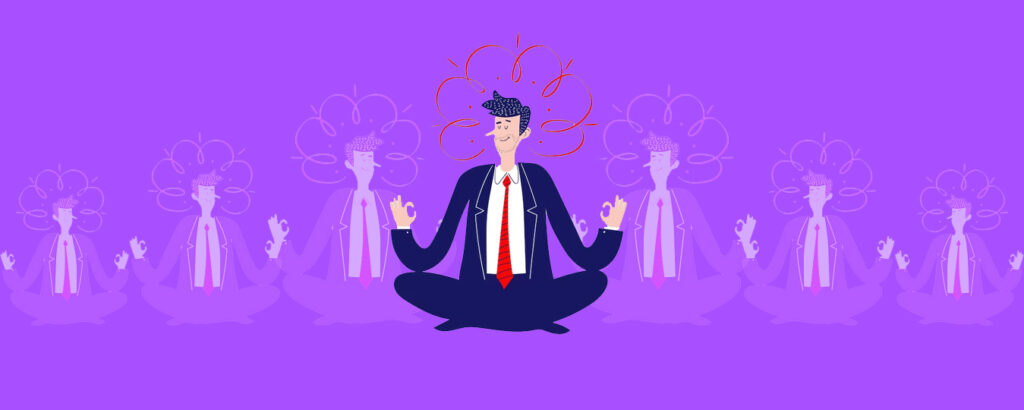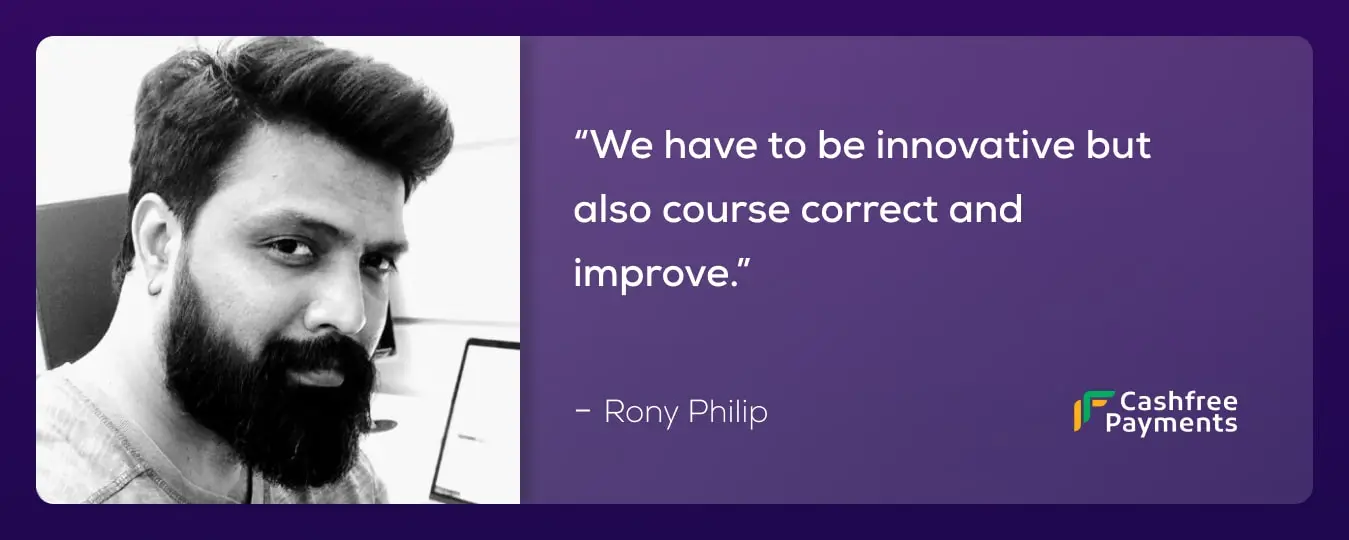Today we have with us Rony Philips, the director of experience design at Cashfree Payments, share his journey and his pearls of wisdom on design thinking. Learning from his way around the world of design, he shares invaluable insights on the philosophy of design enmeshed with the practicality of business and showing the way forward as a leader.
Reflecting on his observations from his decades of experience in the industry, he shares something that every designer should know, expect and be vary of.
“So, I learned from them the science and art of UX and equally learned how it is also important to work with your juniors, your peers, and your senior folks, and collaborate across teams to build that trust and confidence in you and your team and the UX domain. Because it is not an easy domain for everybody to come and say, but everybody has their opinion on designs, and how to make them logical, reasonable, logical, and business-centric. And the technology focus has to be very important. Most of my learning has been practical and not theoretical. I grabbed every opportunity that came my way, whether it was right or wrong, just grab the opportunity, and go for it. Whatever is good, turns out to be good, it’s great. Or you learn from your mistakes.”
One can look back and think – what really influences a design? Is it the designer’s world view, their knowledge or is it the consumer’s view? Are we mirroring designs to create an ideal consumer experience?
“There are hundreds of forums where consumers can make or break your business. So if we don’t listen to our consumers and if we don’t try to align our businesses to our consumers’ voices then they will not use our product. We have to be innovative but also course correct and improve.”
Igniting Design thinking with a Business Mindset

“When I start designing something or coming up with a solution, I start with a business mindset. What am I trying to solve? What is the pain point, and what is the expectation? What are the gaps that we are trying to solve? So, I start with that business mindset. Then, like I said previously, it should be meaningful for both the business and the consumers. Of course, UX is all about building a business solution through empathy and strategy so you need to have empathy. But you also need to have the strategy behind what you’re building because your design has to be sustainable, and maintainable it should have a shelf life. So, we really need to understand how your design is going to impact the revenue.”
Illustrating his point in an animated way, he shares:
“Think about it like you are making a movie, right? The characters cannot make a movie without the collaboration of the smallest denominator who is a light boy or a makeup artist, right? So the writer has to have a good script. The music director has to have good music. Everybody should play their part and they don’t work in Silos, right? The music director needs to understand the situation and make music for that. So the director, writer, actor, music director, everybody has to collaborate together to make the perfect piece of art. So it’s something very similar to that.”
He gives a fair warning to the designers and points out how designers love to work in solitude. So much that they often forget the dream work that comes out of teamwork.
“Once they get the requirement, they really love to take their time. They love to work in silos, come up with all the things. It will work for some time. When you collaborate with various teams, your product manager, your engineers, your teammates, and the sales team, you create something and you take their feedback. And that is the most important thing. Because when they see your perspectives right from the beginning, there’s an easier acceptance and buy-in from those people or those stakeholders, you take a lot of time. So don’t work in Silos!”
He empathizes with the designers on loving your design to the point of defensiveness. It’s your design against the world! Hence, he lovingly advices:
“From a personal perspective, don’t be emotionally attached to your design because it can change. So listen, learn and adapt to certain situations that you are in. Be ready to change your designs. The earlier you change, the faster it will get accepted. Have a design mindset.”
Thinking far ahead of the competition and beyond the finish line

The first and the foremost thing to conquer is your market. To do that, one has to tread fearlessly with a plan. A plan that not only ensures your win but also sustains it.
“In our culture, probably in a startup, we need to move very fast. We need to be first in the market. So, it is very important to customize and change the UX way of working and the process and support this particular environment. Our first focus is always business and we will focus on technology. So there’s a certain velocity at which we are moving forward.We need to be ahead of our competitors.”
“So feature centricity, not future, but the number of features, feature centricity, and innovations, these all take primary importance in the organization. But nevertheless, the time to market is very critical. So from a UX perspective, when I joined very early, I really understood that I needed to align with the business, not immediately join and change the entire culture.”
“UX methodology has got a certain process. We don’t have so much of a levy, so we need to cut the corners logically, and reasonably. As a startup, we have the flexibility to fail fast, right? And then iterate it collaboratively. And then fix something that is low-hanging fruit. We just fix it and then try it out again.”
Taking about improving human experience through UX designs, he shares:
“When was the last time either of you actually carried cash in your wallet? When was the time you physically held a wallet? Sometimes, I ask these Gen Z or Millennials, do you know how to cash a check? Do you know how many signatures are required? What is the meaning of crossing a check? Right? I asked all these questions and they’re like, we have not done that.”
“So, when we design as designers, we use some of the design best practices. For many, we just see if we keep our interaction patterns, and the designs consistent, we are good. Let’s not make any complex interaction patterns. Let’s keep it simple, let’s keep it consistent so that the learning curve is less for the users. That is how we are taking small baby steps to improve the human experience.”
Creating future leaders through example

When asked about his leadership style, Rony takes a humble yet a pioneering approach to leadership.
“Do I have a style of leadership? Probably not. So there are a couple of things that I can say. Probably it’s not the style. I lead by example. So, as a leader, I believe in building an efficient team, not just them being productive, but also being impactful.”
“So, to achieve that, first my team has to have confidence in me, right? They need to have belief in me that, ‘hey, he’s saying all these things, but he’s capable of doing it’, right? So I need to pull up my sleeves and then show how things are working and how things are done.”
“I would say most of these designers come with four or five years of experience pretty young. And with my 20 years, if I can’t give it back to society, I would say I have to lead by that example and help them whenever there is a situation, but not to help them so much that they always lean on me.”
“And I don’t want to go and sit on the top of their head and say, ‘can you show me what you have done? Can you show me?’. We have weekly stand-ups and they just tell me, ‘hey, this is what we are doing’, and I’m okay with it. So the team members come to me when they have a blocker or they want to review their designs.”
“They want to pick my brain or they want to brainstorm a design. That’s when but that’s about being accountable. And as a leader, one of the most important requirements is listening. There’s a difference between hearing and listening. So take time to understand what they are saying.”
“But give a positive criticism or a productive criticism so that they can go and course correct what they have done. At the end of the day, remember that as a leader I am growing the next set of leaders in the market. So if I’m a bad leader, then who is learning from me? They always think that this is the kind of leadership or manager they are looking up to.”
Concluding his thoughts on leadership, he emphasizes on the importance of showing gratitude and encouraging your teammates.
“And finally, from a personal sense, I would say appreciate your teammates. And whenever possible, just go and appreciate saying, “hey, that’s good, man!” So there’s no harm done, right? You build a better value between these two individuals.”
Having the best and worst of both worlds – being the creator and the consumer
“So, I’ve seen both worlds. I have taken the brunt of being a designer, going as a consultant, and then clients always tearing my designs apart and me tearing the designs of when I was a client and me getting the designs. So the one and only factor that I emphasize as a designer or as an agency, is to really understand the breadth and depth of the client’s business area.”
“Don’t go and show that we’ll create four-factor designs and everything because there are hundreds of design templates available right now. And when we say design again, I’ll go to the very first of things that I said, that you are designing a solution, right? You are not designing a look and feel. That is not the intent. You’re designing an experience. You are designing an experience for a business. And a business needs money. It’s all about finance, time to understand business intricacies and the nuances of how it works. And only when you get the clarity of what you are building right, then it becomes easy for you to build what and how to build”
Rapid Fire Questions:
What place do you most want to travel to?
I think Japan is the most beautiful place and I would go there again.
What was the best decision of your career?
I can say many things, but if I look back recently, I was just fortunate to make the decision to join Cashfree. I think that decision was sent to me.
Which historical figure would you choose to meet if given a chance?
I would love to go and see some of the Greek people and the Romans who brought civilizations.
If your life was a story, what would be the title of it?
Happy-go-lucky.
What is a dream that you have yet to achieve?
If I want a dream, I’ll go and sleep. What do I want to achieve? No ma’am. I’m just happy with whatever I’ve got.




